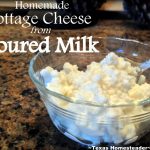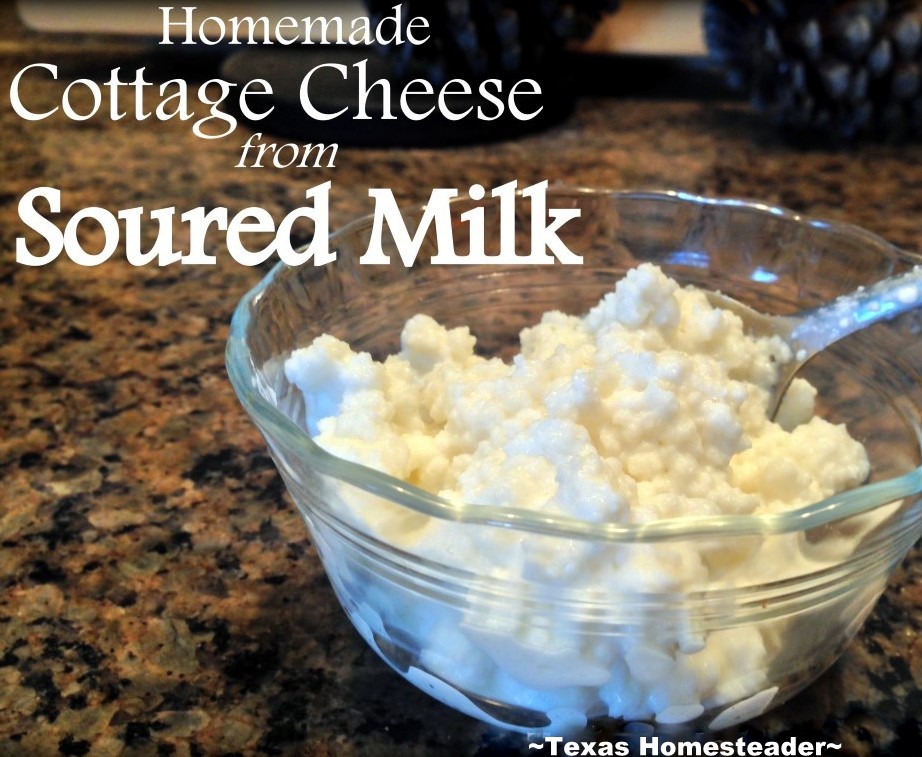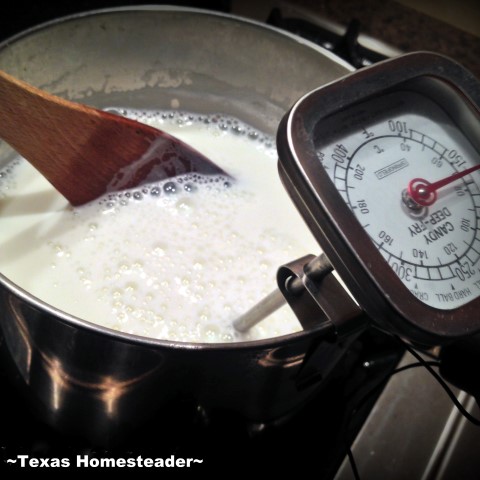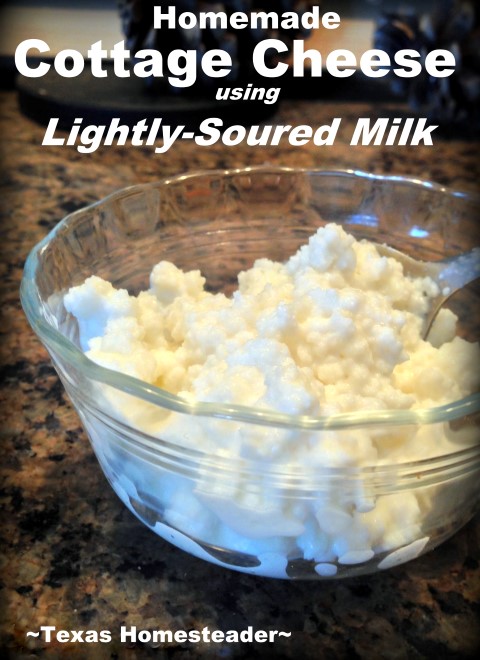by Texas Homesteader ~
I often use lightly-soured milk to make my own delicious cottage cheese. This reduces our food waste and provides delicious food too.
Reducing Food Waste In Our Home
I love cottage cheese & used to buy it and keep it handy for serving along with cold peaches or cantaloupe for breakfast. But then I found out how easy it was to make delicious cottage cheese yourself.
And (here’s the kicker) I make it with lightly soured milk that in the past I’d just throw away.
Zero-Food-Waste Warriors: UNITE!
Sometimes travel or just the busyness of our lives means milk sits in the fridge long enough that it’s not as flavorful to drink anymore. It’s become lightly soured.
Now I’m not talking about actual SPOILED milk here. I’m just speaking of milk a little too close to (or even just past) the date on the carton. That’s when the flavor starts to change somewhat.
In the past although I hated to throw it away, I’d sigh and pour it down the drain. What a waste!
How To Use Sour Milk
Then I thought for a moment – you can use lightly soured milk for making biscuits, sandwich bread or pancakes. I wonder if there’s another way to use it. I’ll make homemade cottage cheese!
Of course I’d never try this with SPOILED milk, but lightly soured milk is perfect to use for making cottage cheese.
On this occasion I had about half a gallon of milk remaining & it was just past the date on the carton.
To Make Cottage Cheese, Heat Lightly-Soured Milk
I poured that milk into a pan and heated it to 185 degrees. I was careful not to let the milk get hotter than that since too much heat delivered too fast could change the texture of the curds and make them rubbery. Low & slow heat is best.
After my milk reached 185 degrees I stirred in a tablespoon of plain white vinegar. The the vinegar provides the acid the milk needs for separating the curds from the whey.
Using a gentle stirring motion with a wooden slotted spoon I stirred about 3-4 minutes. If needed I can add another tablespoon of vinegar after a couple of minutes of stirring if I don’t get the separation I’m looking for. I want the remaining whey to be almost clear.
After a few minutes I figured the curds were as separated as they would get and my whey was clear.
How To Strain Cottage Cheese Curds
So I turned off the heat & poured the hot curds & whey into a colander that had been lined with cheesecloth. I let the curds drip until the whey was all drained off.
I reserved that whey for use next time I’m making my homemade bread. What a perfect way to use a byproduct of my cottage cheese. It not only adds a little extra nutrition but also more flavor.
So I allowed the whey to cool and placed it in a glass jar & stored it in my refrigerator. I’ll be sure to use it the next time I make my homemade KitchenAid sandwich bread!
Now that the curds are drained and cooled I crumbled the curds with my freshly-washed hands to the size I wanted them to be. You can keep the curds large or crumble them smaller, but I prefer the smaller curds. This kind of flexibility is the beauty of making it yourself!
I finished with just over a cup of curd. (Your quantity of curds could vary based on what kind of milk you’re using. Whole milk will give more curds, 2% milk will give you less, skim milk will give you much less) To my curds I added about 1/2 teaspoon of salt, but I guess that’s totally optional.
Then I splashed in just enough fresh milk to give it a creamy texture. If you have half & half that will make it even creamier and more like what you’d buy in the store. But I seldom buy cream so I just use milk.
Whether skim, 2% or whole milk, I’m just splashing in a small amount and stirring it in. It always works just fine for me that way.
Delicious Homemade Cottage Cheese
After a quick stir to combine the curds, milk & salt and I’m done. Making this cottage cheese is even easier & quicker than making Homemade Yogurt!
And I love that this soured milk wasn’t wasted as it certainly would have been in years gone by. What a delicious way to further reduce my food waste!
I store my cottage cheese in a repurposed glass jar in the fridge, and typically enjoy it with cold slices of cantaloupe from my garden. Delicious!
I’m sharing the recipe below for about 1/2 gallon of soured milk. You may need to adjust some of the ingredients based on the amount of soured milk you actually have.
Did you make this cottage cheese? Please rate the recipe in your comment below!

Homemade Cottage Cheese
Ingredients
Ingredients:
- 1/2 gallon lightly soured milk
- 1 Tablespoon white vinegar
- 1/2 teaspoon salt, optional
- Splash of fresh milk
Instructions
Directions:
-
Pour 1/2 gallon of lightly-soured milk into a pan. Heat milk to 185 degrees. (Don't heat higher than that or the curds may become an unpleasant texture.)
-
Add 1 Tablespoon plain white vinegar and stir continuously until milk curds separate from the whey. It could take three to four minutes for all the curds to separate.
-
Strain separated milk into cheesecloth-lined colander and allow the milk curds to cool. When they are cool enough to handle, break up curds to the size you like them using clean hands. If desired add 1/4 teaspoon salt or to taste (optional). Stir in a splash of fresh milk, cream or half-and-half.
-
ENJOY!
Recipe Notes
NOTE: If 1 tablespoon of vinegar doesn't separate the curds enough, you can add vinegar 1 tablespoon at a time every 2 minutes or so until you get the separation you need and whey is almost clear.
~TxH~
Other Favorite Condiments
- Homemade Mayonnaise
- Baconnaise – Bacon-Flavored Mayonnaise
- Fast Food: Basic Mix-n-Pour BBQ Sauce
- Honey-Sweetened, Smoky BBQ Sauce
- BBQ Rub & Beer-Based Mop Sauce Recipe
- Thousand Island Salad Dressing
- 1-Minute Creamy Salad Dressing Filled With Probiotics
- Sweet/Savory Pear Relish
- Fresh Pico de Gallo
- Homemade Cottage Cheese
- Fresh Herb & Olive Oil HERB BOMBS
- Quick Garlic/Herb Sauce Using Fresh Herbs
- Oats Can Substitute Easily For Bread Crumbs
- MYO Pinto Bean Seasoning Mix
- Instant Pot Boiled Eggs WITHOUT The Shells
- Creamy Hatch Chile Sauce
- MYO Healthier Sour Cream Substitute
- How to Make Self-Rising Flour Using All-Purpose
…and MUCH more
See ALL Our Delicious Recipes!
C’mon by & sit a spell! Come hang out at our Facebook Page. It’s like sitting in a front porch rocker with a glass of cold iced tea – lots of good folks sharing!
You can also follow along on Pinterest, Twitter or Instagram.
To receive an email when a new blog post goes live it’s EASY to
Subscribe to our blog!






The only reason I give this recipe 2 stars is because you’re not going to get much of anything done with only 1 tbsp of vinegar let alone 4. I used about 1 cup of vinegar to 1 gallon. There’s no vinegar taste and you know you’ve completely used it when it’s a clearish yellow liquid left over. When I followed the recipe as written the liquid left over was still white which is not what you want. That means you still have a lot more cheese in there and the point of this is not to waste it. The steps are good its the measurement that’s off. I got over 2 cups of cottage cheese from this.
I always start with a Tablespoon of vinegar and note in the recipe to add another Tablespoon every couple of minutes if you don’t get the separation you want. I’ve always been concerned about vinegar taste infiltrating my cottage cheese so I always start with the least amount possible & only add if needed. So your comment about no vinegar taste even with more vinegar is helpful. I do process until the whey is completely separated from the curd, and I got just over a cup with 1/2 gallon of milk whereas you’ve mentioned you got over 2 cups with a gallon so we’re pretty close in our yields. Thank for your feedback. ~TxH~
This really works! I’ll never throw away soured milk again!
I just found my 2 x full gallons of 2% were turning tonight. So gave this a shot. Ended up with roughly 2cups of cheese. Soft, smaller curds.
I didn’t have a thermometer, so “experienced” it and chucked in the vinegar when I felt it was warm enough by touch.
Tastes good. Will definitely try it with full milk sometime. Going to use about 4 cups of whey when making fried chicken tenders tomorrow.
Great job, Clair. 2 gallons is a whole lot of potential food waste diverted. And you even have a plan for the whey – something I always struggle with. I’ve used it when making bread but wasn’t pleased in the change of taste/texture. How will you use it with your chicken tenders? ~TxH~
This sounds just like when Miss Susie showed me how to make ricotta cheese. Only we didn’t add milk afterward. I used to get raw milk from some Mennonite friends down the road from us and I’d make butter. I would drain the buttermilk of and use that in my bread and biscuit recipes.
I end up with a partial gallon of milk that’s lightly soured more often than I’d like to admit, Nancy. I’m thrilled to have something to do with it now instead of just pouring it down the drain. ~TxH~
Oooh, thanks for this recipe, I have copied it out and will be trying it soon. I had to laugh about saving the whey, since years ago I made cheese for the first time, using a gallon of fresh goat’s milk a friend gave me for helping her with a project. I followed the instructions to the letter, and I ended up with a pretty nice little round of cheese that tasted good. I looked at the whey left in the big pot, and since I hate to waste anything, I wondered how I could use it. I knew it could be fed to some livestock, but at that time I didn’t have any, nor did I know you could bake with it. Then I recalled that old nursery rhyme about Little Miss Muffet, “eating her curds and whey”. I thought okay, I’ll give it a try. I scooped out a cup of the still warm liquid and took a big swallow. Oh. My. GOSH! I now knw where the goat smell went–it was in the WHEY! I spit it out, but not before I choked and it went up my nose and out over my face and neck. I rinsed my mouth, then brushed my teeth and gargled several times, washed my face–I could NOT get rid of the smell and taste. All I could smell for days was goat. I decided that if Little Miss Muffet could eat THAT stuff, why the heck was she scared of a spider?
Oh man, you gave me quite the chuckle this morning Evelyn. (note to self, do NOT try to taste goat-milk whey!) ~TxH~
I agree, homemade cottage cheese is so good, & easy to make. I wish I had thought of using slightly soured milk, I just threw some away! D-:=
Although I love cottage cheese, RancherMan will have nothing to do with it. So I don’t buy it. But if ever there’s milk that’s starting to lose its drinkability I know it won’t be wasted and I’ll finally get to enjoy cottage cheese too! ~TxH~